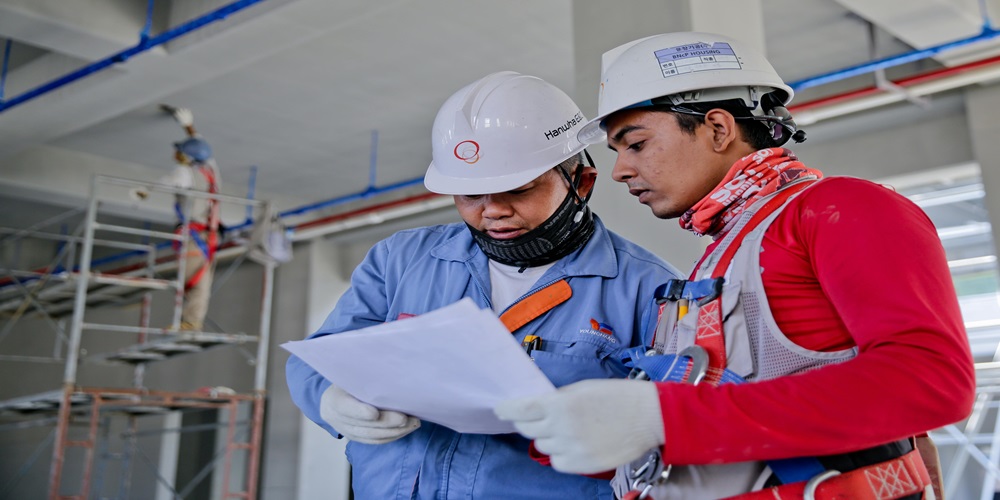The Role of Site Managers in Promoting Health and Safety on Construction Projects

When it comes to the bustling world of construction, where heavy machinery roars and workers hustle amidst towering scaffolds, one unsung hero often stands at the forefront of safety: the site manager. Picture them as the conductors of an orchestra, harmonizing diverse teams while deftly navigating potential hazards lurking around every corner. Ensuring that every beam is secured and no worker’s health is compromised isn’t just part of their job; it’s a commitment to fostering a culture that prioritizes well-being above all. In this blog post, we’ll dive deep into how site managers play a pivotal role in promoting health and safety on construction projects—transforming chaotic environments into safe havens where productivity thrives without jeopardizing lives. Join us as we explore their responsibilities, strategies, and the profound impact they have on building not only structures but also safer work environments!
Introduction: Importance of Health and Safety in Construction
Construction sites are bustling with activity, filled with heavy machinery, high stakes, and ambitious deadlines. Amidst this whirlwind of progress, one critical factor often determines the success or failure of a project: health and safety. Ensuring that workers return home safely at the end of each day is paramount in an industry where risks can be as varied as they are unpredictable. This is where site managers step into the spotlight.
These dedicated professionals play a pivotal role in setting standards and implementing practices that prioritize well-being on construction projects. Their commitment to fostering a safe work environment not only protects lives but also enhances productivity and morale among teams. Understanding their responsibilities can shed light on how effective health and safety roles in construction truly make a difference—both for individuals on-site and for the overall success of any project.
What is a Site Manager?
A site manager is a pivotal figure on any construction project. They act as the bridge between various stakeholders, ensuring smooth communication and workflow.
Their responsibilities span from overseeing daily operations to managing resources effectively. Site managers coordinate tasks among workers, subcontractors, and suppliers to keep projects on track.
Typically, they possess strong leadership skills and a deep understanding of construction processes. This knowledge allows them to make informed decisions quickly.
Moreover, site managers often solve problems that arise unexpectedly—whether it’s addressing delays or resolving conflicts among team members. Their ability to think on their feet ensures that projects continue progressing despite challenges.
In addition to technical know-how, successful site managers embody excellent communication skills. They must convey complex information clearly so everyone understands safety protocols and project goals alike.
The Role of a Site Manager in Promoting Health and Safety
A site manager plays a pivotal role in safeguarding health and safety on construction sites. They are the backbone of risk assessment and management, identifying potential hazards before they escalate into serious issues.
Site managers implement crucial safety protocols that define how tasks should be performed. This ensures that every worker understands the importance of following guidelines to minimize risks.
Monitoring is another key responsibility. Site managers continuously observe work practices, ensuring compliance with established safety measures. If something seems off, they take immediate action to correct course.
Through regular communication with the team, site managers foster an environment where everyone feels empowered to speak up about safety concerns. This open dialogue encourages proactive behaviors among workers, enhancing overall site safety culture.
– Risk assessment and management
Risk assessment and management is a fundamental responsibility for site managers in the construction industry. It involves identifying potential hazards before they become problematic.
Site managers conduct thorough evaluations of the work environment. This process helps them understand what risks may arise from specific tasks or conditions on-site. By anticipating these dangers, they can implement strategies to mitigate them effectively.
Regular assessments allow site managers to stay ahead of emerging issues. Changes in weather, materials, or personnel can introduce new risks that require immediate attention.
Moreover, effective communication plays a crucial role here. Engaging with workers about identified risks fosters a culture of safety where everyone feels responsible for their well-being.
Ultimately, proactive risk management not only protects workers but also enhances the overall efficiency of construction projects by reducing downtime caused by accidents or injuries on-site.
– Implementation of safety protocols
Implementing safety protocols is a critical responsibility for site managers on construction projects. These protocols serve as the backbone of any effective health and safety strategy.
Site managers must ensure that all workers are familiar with these guidelines before they step onto the site. Clear communication about procedures helps everyone understand their roles in maintaining a safe working environment.
Regular training sessions can reinforce this knowledge, giving workers hands-on experience with safety equipment and emergency response plans. This proactive approach builds confidence among team members.
Moreover, adapting these protocols based on real-time observations can enhance effectiveness. Site managers should be open to feedback from workers who are directly engaged in daily tasks.
By fostering a culture of compliance and vigilance, site managers not only protect their workforce but also promote overall project efficiency. The commitment to implement robust safety measures reflects an organization’s dedication to well-being on-site.
– Monitoring and enforcement of safety measures
Monitoring and enforcing safety measures is a crucial aspect of a site manager’s role in construction. Regular observation helps identify potential hazards before they escalate into serious issues.
Site managers conduct frequent walk-throughs to ensure compliance with established protocols. They observe workers, equipment use, and overall site conditions. This proactive approach allows them to spot violations or unsafe practices early on.
Enforcement means taking appropriate action when safety standards are not met. It could involve retraining staff, issuing warnings, or even halting work until issues are resolved.
Documentation plays an integral part as well. Keeping detailed records of inspections and incidents ensures accountability and provides valuable insights for future projects.
By creating an environment where safety is prioritized, site managers foster a culture that values health and well-being on the job site. Their vigilance can ultimately lead to fewer accidents and injuries over time.
Responsibilities of a Site Manager in terms of Health and Safety
A site manager carries significant responsibilities when it comes to health and safety. One of their primary duties is ensuring that all workers receive proper training in safety protocols. This knowledge empowers employees to recognize hazards and act appropriately.
Regular inspections and audits are another crucial aspect of a site manager’s role. These evaluations identify potential risks, allowing for timely interventions before accidents occur.
Moreover, effective communication with stakeholders cannot be overlooked. Site managers must relay information about health and safety measures clearly to clients, subcontractors, and the workforce. Keeping everyone informed fosters a culture of safety on the job site.
By prioritizing these responsibilities, site managers create an environment where health and safety thrive alongside productivity. It’s essential for them to remain vigilant in their efforts as they navigate daily challenges while maintaining compliance with industry standards.
– Ensuring proper training for workers
Training is the cornerstone of a safe construction site. It equips workers with essential knowledge about potential hazards and safe practices.
Site managers play a crucial role in ensuring that all team members receive proper training. This includes not only onboarding for new hires but also ongoing education for existing staff. Regular refreshers keep safety top-of-mind.
Interactive sessions can enhance understanding, allowing workers to ask questions and engage with real-life scenarios. Hands-on training is particularly effective, as it prepares them for challenges they may face on-site.
Additionally, offering specialized training programs tailored to specific roles boosts confidence and competence among workers. Site managers should actively seek feedback from employees post-training to identify areas needing improvement.
By prioritizing comprehensive training, site managers foster a culture of safety that resonates throughout the entire project lifecycle. An informed workforce is an empowered one, ready to tackle risks head-on while maintaining health and safety standards.
– Regular safety inspections and audits
Regular safety inspections and audits are critical for maintaining a secure construction site. These evaluations ensure that all safety protocols are being followed consistently.
During an inspection, site managers identify potential hazards before they escalate into serious problems. They assess equipment, work practices, and compliance with established regulations. This proactive approach reduces the risk of accidents significantly.
Audits extend beyond immediate observations; they also analyze historical data on incidents and near-misses. By reviewing past occurrences, managers can implement more effective safety measures tailored to specific risks associated with their projects.
Additionally, these assessments foster a culture of accountability among workers. When team members know that regular checks occur, they’re more likely to adhere to safety standards diligently.
Ultimately, routine inspections and audits serve as essential tools in promoting health and safety roles in construction sites while ensuring everyone returns home safely at the end of each day.
– Communication with stakeholders about health and safety measures on the site
Clear communication with stakeholders is crucial in promoting health and safety on construction sites. Site managers must ensure that everyone involved understands the safety measures in place. This includes workers, subcontractors, clients, and regulatory bodies.
Regular meetings can facilitate open dialogue about ongoing risks or concerns. Sharing updates on safety protocols fosters a culture of transparency. Stakeholders should feel empowered to voice their questions or suggestions regarding health and safety practices.
Additionally, utilizing visual aids like signage helps reinforce important messages about site hazards and safe practices. Information dissemination through newsletters or digital platforms keeps everyone informed of new developments.
By actively engaging stakeholders in discussions around health and safety measures, site managers cultivate an atmosphere where everyone contributes to maintaining a safe working environment.
Challenges Faced by Site Managers in Ensuring Health and Safety
Site managers encounter various challenges when prioritizing health and safety on construction sites. Time constraints often loom large, with tight deadlines pushing them to expedite processes. This rush can lead to oversight in crucial safety measures.
Budget limitations add another layer of complexity. With financial resources stretched thin, site managers may struggle to invest in comprehensive training or high-quality safety equipment. Such compromises can undermine the effectiveness of health protocols.
Additionally, adherence to ever-evolving regulations presents a constant hurdle. Keeping up with local and national standards requires ongoing education and vigilance. Misunderstanding these laws can result in costly penalties or unsafe work environments.
Balancing all these factors demands exceptional organizational skills and resilience from site managers as they navigate the intricate landscape of construction projects while ensuring worker safety remains a top priority.
– Time constraints
Time constraints are a significant challenge for site managers in the construction industry. Tight schedules often push teams to rush through tasks, which may compromise safety.
When deadlines loom, the pressure mounts. This urgency can lead workers to skip essential safety protocols or overlook risks. Site managers must balance productivity with health and safety responsibilities.
Effective time management is crucial. Planning ahead helps ensure that all safety measures are integrated into daily operations without delays.
Additionally, frequent communication among team members about timelines and expectations fosters a culture of awareness regarding potential hazards.
Creating realistic timelines that prioritize both project completion and worker well-being remains vital in overcoming time-related challenges on construction sites.
– Budget constraints
Budget constraints are a common challenge for site managers in the construction industry. Limited financial resources can significantly affect health and safety initiatives on-site.
When funds are tight, prioritizing safety equipment and training becomes more difficult. Managers may struggle to provide workers with the essential protective gear they need. This can lead to increased risk of accidents and injuries.
Moreover, budget limitations often restrict regular safety audits or inspections. These assessments play a crucial role in identifying hazards before they escalate into serious issues.
Investing in comprehensive training programs is also impacted by financial restrictions. Without adequate training, workers may lack the knowledge to recognize potential dangers properly.
Site managers must navigate these challenges creatively while still ensuring that health and safety remain at the forefront of operations. Balancing cost efficiency with robust safety measures requires strategic planning and innovative thinking.
– Adherence to regulations and standards
Adherence to regulations and standards is paramount in the construction industry. Compliance ensures that all safety protocols are not merely suggestions, but legal obligations. Site managers must stay updated on local, national, and industry-specific regulations.
Navigating these rules can be daunting. Each project may present unique challenges concerning compliance with environmental laws or worker safety guidelines. A thorough understanding of these requirements helps site managers avoid potential penalties and costly delays.
Additionally, maintaining adherence fosters a culture of safety among workers. When everyone understands the importance of following established standards, it promotes accountability on-site. This collective responsibility enhances overall workplace safety.
Regular training sessions can help keep everyone informed about any changes in regulations or best practices. By prioritizing adherence to health and safety standards, site managers play a crucial role in minimizing risks associated with construction projects.
Best Practices for Site Managers to Promote Health and Safety on Construction Sites
Site managers play a pivotal role in promoting health and safety on construction sites. To enhance their effectiveness, they can adopt several best practices.
First, staying informed about the latest regulations and safety standards is essential. This knowledge helps site managers ensure compliance while fostering a culture of safety among workers.
Regularly conducting risk assessments should be part of the routine. Identifying potential hazards early allows for proactive measures to minimize risks before they escalate into accidents.
Implementing clear communication channels is crucial. Site managers must encourage open discussions about safety concerns with workers and stakeholders alike. Regular meetings focused on health and safety reinforce its importance in daily operations.
Another effective practice involves training programs tailored to specific tasks performed on-site. Offering hands-on training prepares employees for real-world scenarios, enhancing their ability to respond appropriately in emergencies.
Finally, embracing technology can significantly improve monitoring efforts. Tools such as drones or mobile apps provide an innovative way to oversee site conditions and track compliance with health and safety protocols efficiently.
By adopting these best practices, site managers not only fulfill their responsibilities but also create safer working environments that benefit everyone involved in construction projects. Promoting health and safety roles within this sector ultimately leads to improved productivity as well as better job satisfaction among workers.
Conclusion
In conclusion, the role of site managers in promoting health and safety on construction projects is crucial for the well-being of workers and the success of a project. By implementing proper risk assessment protocols, enforcing safety regulations, and providing adequate training and resources, site managers can significantly reduce accidents and injuries on construction sites. It is essential for all stakeholders to recognize the importance of prioritizing health and safety in order to create a safe working environment for everyone involved in construction projects. Only through collaboration and commitment can we ensure that every worker goes home safely at the end of each day.





